How to Unclog a Clogged Drain?
Clogged drains are a common household issue, typically caused by a buildup of grease, soap scum, hair, and food particles inside pipes. In kitchen sinks, grease is often the main culprit, while bathroom drains frequently clog with hair and soap scum. When these substances accumulate, they block the flow of water, leading to symptoms like slow drainage, foul odors, and gurgling sounds. If left untreated, clogs can cause serious problems like water backup, pipe damage, and unpleasant odors, which may eventually lead to more costly repairs.
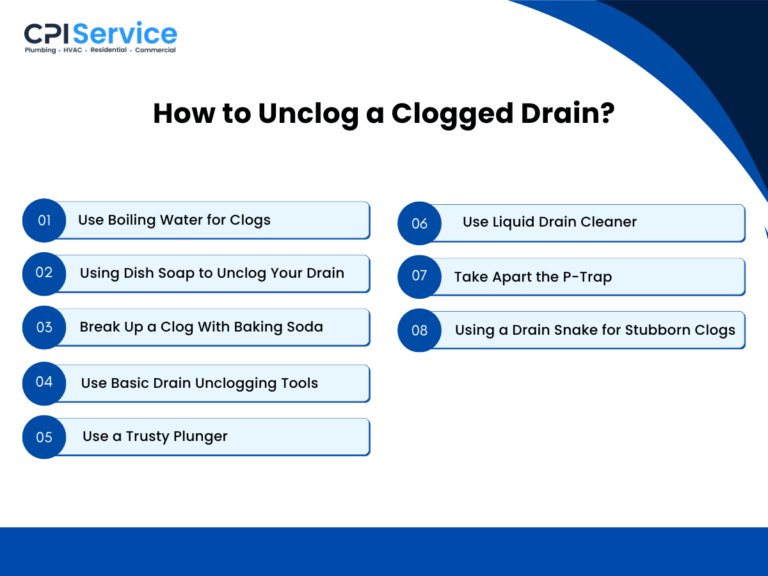
To unclog a drain, start with simple DIY methods like pouring boiling water down the drain, using dish soap to break down grease, or trying a baking soda and vinegar solution. In more severe cases, mechanical tools like plungers or drain snakes may be needed to push or retrieve debris deeper within the pipes. When these methods fail, you should call a plumber for more permanent solutions like drain augers, hydro jetting machines, and video camera inspections. These methods help clear stubborn blockages, including tree roots or heavy grease buildup, and ensure long-term results without further damage to your plumbing system.
Below are the top 8 methods for unclogging a drain:
- Use Boiling Water for Clogs
- Using Dish Soap to Unclog Your Drain
- Break Up a Clog With Baking Soda
- Use Basic Drain Unclogging Tools
- Use a Trusty Plunger
- Use Liquid Drain Cleaner
- Take Apart the P-Trap
- Using a Drain Snake for Stubborn Clogs
1. Boiling Water for Clogs

Boiling water is an effective method for unclogging drains caused by grease, soap scum, or food debris, as the high temperature helps to break down and dissolve these substances. The heat softens and liquefies grease, making it easier for the water to flush it through the pipes. This method works best in kitchen sinks where grease buildup is common, or in bathroom drains clogged with soap scum.
To use this method, bring a kettle or pot of water to a rolling boil and carefully pour it down the drain in stages, allowing the hot water to sit for a few seconds between pours. Pouring in stages helps the water maintain its temperature, which is crucial for breaking down clogs. This technique is effective for minor clogs but should be avoided with standing water or older pipes, as the extreme heat could cause damage to brittle or plastic plumbing.
2. Using Dish Soap to Unclog Your Drain
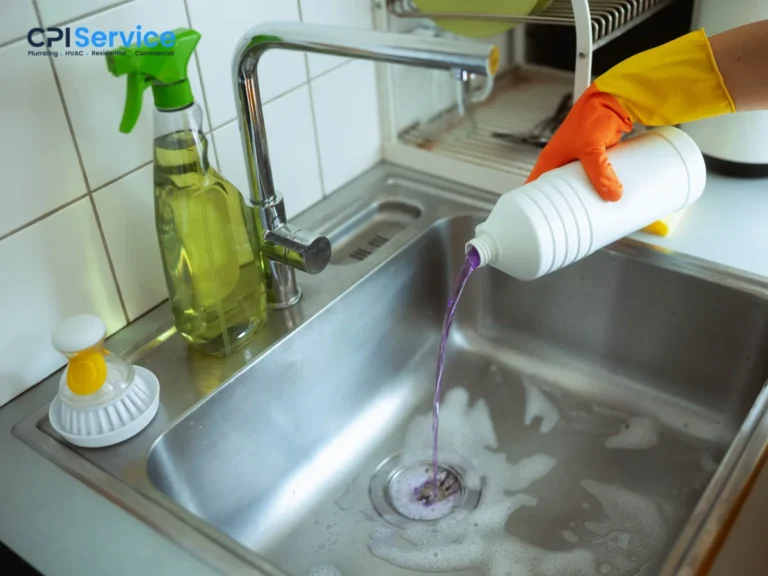
Dish soap is an effective solution for grease-based clogs, particularly in kitchen drains. Its degreasing properties help emulsify grease, allowing it to mix with water and flow more easily through the pipes.
To use the dish soap, pour half a cup of dish soap into the clogged drain, followed by a pot of boiling water. Let it sit for 10–15 minutes, then flush with hot water to clear the debris. This method works best for fresh, greasy clogs but may be less effective for older, tougher blockages.
How Dish Soap Helps Break Down Grease?
Dish soap helps break down grease through a process called emulsification, where soap molecules interact with grease molecules to form a stable mixture. Dish soap molecules are made of hydrophilic (water-attracting) and hydrophobic (water-repelling) ends. The hydrophobic end binds to the grease molecules, while the hydrophilic end binds to the water. This allows the grease, which normally does not mix with water, to become dispersed in the water, turning it into smaller, more manageable droplets.
The process significantly lowers the viscosity of the grease, making it less sticky and easier to flush away. The reduction in surface tension makes the grease less likely to cling to the walls of the pipes. This is particularly effective in kitchen drains where grease from cooking oils and fats often accumulates. By using dish soap and hot water, you can effectively emulsify and wash away the grease buildup without the need for harsh chemicals.
3. Break Up a Clog With Baking Soda
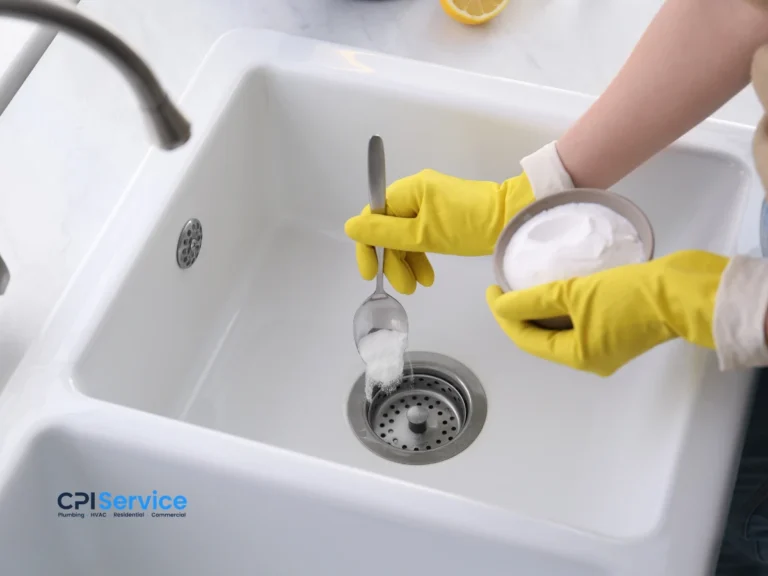
Baking soda is an eco-friendly and effective solution for clearing mild clogs, particularly those caused by soap scum, grease, or organic debris. When combined with vinegar, baking soda creates a natural chemical reaction that helps to break down clogs and remove buildup. This method is safe for most plumbing systems and can be a great option for regular maintenance.
To use, pour half a cup of baking soda into the clogged drain, followed by one cup of vinegar. Let it sit for about 15 minutes, then flush the drain with boiling water to clear away the loosened debris. This method works best for organic clogs but may not be effective for tougher blockages.
How Baking Soda Breaks Down Clogs?
Baking soda breaks down clogs through a chemical reaction with vinegar. When combined, the alkaline properties of baking soda react with the acidic properties of vinegar to form carbonic acid, which rapidly decomposes into carbon dioxide and water. The carbon dioxide creates bubbles that help loosen the clog by agitating the debris in the drain. This pressure disrupts the blockage, while the mild abrasiveness of baking soda scrubs away residue, helping to clear organic clogs like grease, soap scum, and hair.
4. Use Basic Drain Unclogging Tools

Basic drain unclogging tools, such as a plunger, drain snake, and zip-it tool, are essential for tackling more stubborn blockages that cannot be cleared with simple methods. These tools provide mechanical force to dislodge or remove the clog, making them ideal for deeper or more persistent blockages. However, for unique or extreme cases of clogs, such as complex tree root blockages or severe grease buildup, additional specialized tools and methods may be required.
Here are some essential tools to consider for unclogging your drain:
- Plunger: Best for shallow blockages in sinks, tubs, and toilets. It creates pressure to push the clog through the pipes.
- Drain Snake: Ideal for deeper clogs that are further down the drain. The flexible cable helps break up or retrieve debris stuck in the pipes.
- Zip-It Tool: A plastic, flexible tool designed to remove hair and other debris from bathroom drains, especially useful for sink and shower clogs.
- Hand Auger: A manual version of the drain snake, often used for tougher blockages in toilets and pipes, with a longer reach and rotating handle to break through the obstruction.
- Plumbing Bladder: A pressure tool that expands inside the pipe and uses water pressure to clear blockages, especially useful for stubborn clogs caused by debris or tree roots.
- Wet/Dry Vacuum: Useful for removing standing water and debris from the drain. The suction power can help pull out the clog, especially if it is near the surface.
- Drain Cleaning Brushes: Effective for cleaning the inside of drain pipes and clearing buildup from mineral deposits, soap scum, or other residues. These brushes come in various sizes to reach deep into pipes and scrub away the debris.
- Rooter Machine: A more powerful version of a drain snake, this tool is especially useful for clearing tree root blockages in main sewer lines, making it essential for plumbing systems affected by root intrusion.
- Hydro Jetting: A highly effective method for removing heavy grease, debris, or tree roots deep inside pipes. This tool uses high-pressure water streams to thoroughly clean and clear out even the most stubborn blockages in residential or commercial plumbing systems.
5. Use a Trusty Plunger
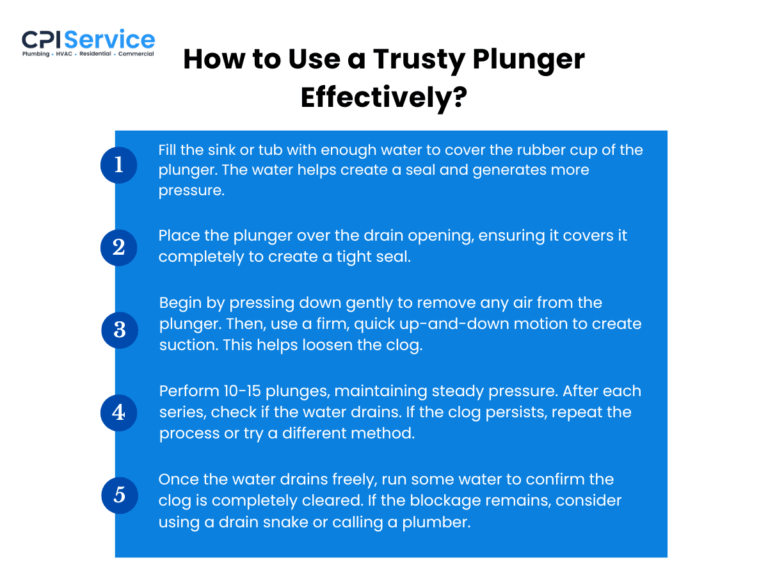
A plunger is a simple yet effective tool for clearing shallow clogs in sinks, tubs, and toilets by creating pressure that pushes the blockage through the pipes. It is ideal for removing blockages caused by waste, soap scum, or small food particles. While it is a basic tool, using it properly ensures the best results for minor drain obstructions.
How to Use a Plunger Effectively?
To effectively clear a clog with a plunger, ensure you are using the right type for the job: a flat-bottomed plunger for sinks and tubs, and a flange plunger for toilets. Here’s how to use it:
- Fill the sink or tub with enough water to cover the rubber cup of the plunger. The water helps create a seal and generates more pressure.
- Place the plunger over the drain opening, ensuring it covers it completely to create a tight seal.
- Begin by pressing down gently to remove any air from the plunger. Then, use a firm, quick up-and-down motion to create suction. This helps loosen the clog.
- Perform 10-15 plunges, maintaining steady pressure. After each series, check if the water drains. If the clog persists, repeat the process or try a different method.
- Once the water drains freely, run some water to confirm the clog is completely cleared. If the blockage remains, consider using a drain snake or calling a plumber.
6. Use Liquid Drain Cleaner
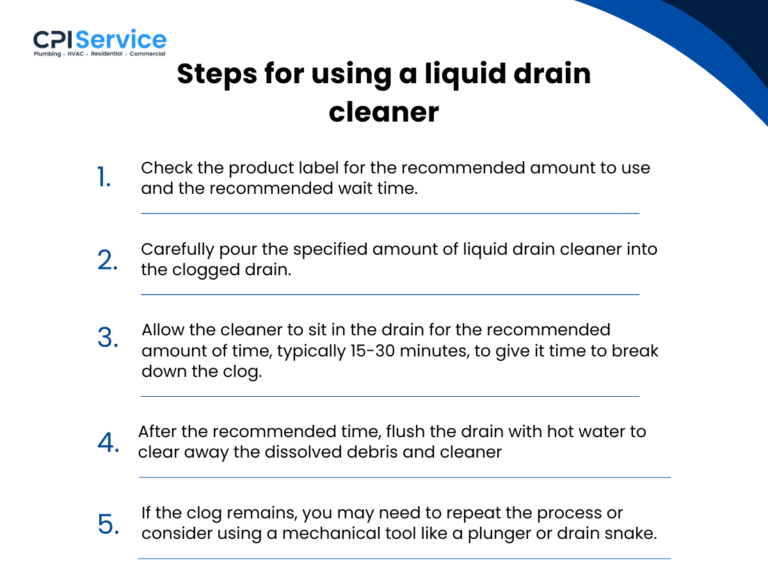
Liquid drain cleaners are chemical solutions that can help break down tougher clogs, particularly those caused by grease, soap scum, or organic material. These cleaners are designed to dissolve the obstruction, allowing water to flow freely through the pipes again. While they are effective for some blockages, they should be used with caution as they can damage pipes if used improperly or too frequently.
Here are the steps for using a liquid drain cleaner:
- Check the product label for the recommended amount to use and the recommended wait time.
- Carefully pour the specified amount of liquid drain cleaner into the clogged drain.
- Allow the cleaner to sit in the drain for the recommended amount of time, typically 15-30 minutes, to give it time to break down the clog.
- After the recommended time, flush the drain with hot water to clear away the dissolved debris and cleaner.
- If the clog remains, you may need to repeat the process or consider using a mechanical tool like a plunger or drain snake.
7. Take Apart the P-Trap
The P-trap is a U-shaped pipe beneath sinks designed to prevent sewer gases from entering your home. It can sometimes become clogged with debris, hair, or grease, causing slow drainage or a complete blockage. Taking apart the P-trap allows you to access the clog directly and clear it out. However, this process requires some care to avoid spills and reassembly issues.
How to Safely Take Apart the P-Trap?

To safely take apart the P-trap and clear the clog, follow these steps:
- Place a bucket or towel under the P-trap to catch any water or debris that may spill out when you remove the pipe.
- While not always necessary, turning off the water supply can help prevent accidental spills.
- Use your hands or a wrench to loosen the slip nuts on both ends of the P-trap. Be careful not to overtighten when reassembling.
- Once the nuts are loose, carefully remove the P-trap from the drain pipes. Be prepared for any water or debris that may spill out.
- Inspect and clean the P-trap for any debris, hair, or buildup. You can use a pipe brush or a cloth to remove any clogs inside.
- After cleaning, align the P-trap back into place, ensuring the slip nuts are securely tightened. Test the drain by running water to ensure everything is sealed properly and draining smoothly.
8. Using a Drain Snake for Stubborn Clogs
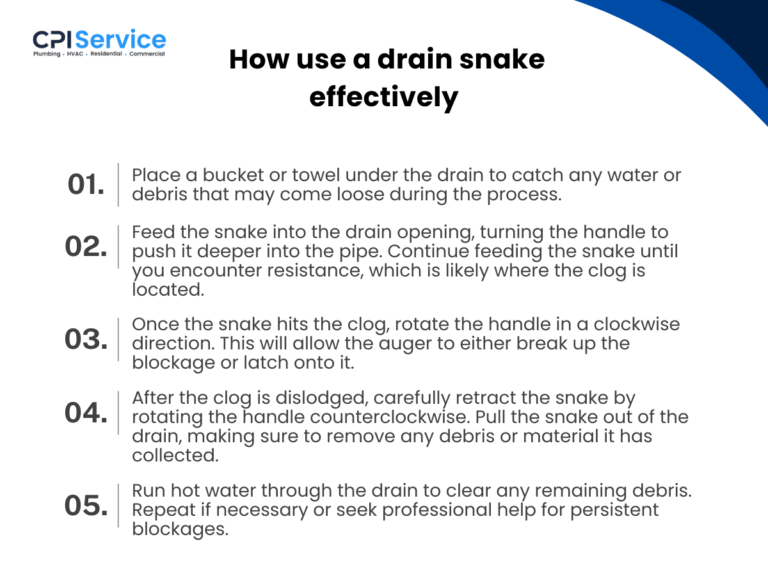
A drain snake is a highly effective tool for clearing stubborn blockages deep within the pipes that cannot be resolved with plungers or liquid drain cleaners. Also known as a plumbing auger, it consists of a long, flexible coil of metal that is fed into the drain and rotated to break up or retrieve the clog caused by debris, hair, or grease buildup.
To use a drain snake effectively, follow these steps:
- Place a bucket or towel under the drain to catch any water or debris that may come loose during the process.
- Feed the snake into the drain opening, turning the handle to push it deeper into the pipe. Continue feeding the snake until you encounter resistance, which is likely where the clog is located.
- Once the snake hits the clog, rotate the handle in a clockwise direction. This will allow the auger to either break up the blockage or latch onto it.
- After the clog is dislodged, carefully retract the snake by rotating the handle counterclockwise. Pull the snake out of the drain, making sure to remove any debris or material it has collected.
- Run hot water through the drain to clear any remaining debris. Repeat if necessary or seek professional help for persistent blockages.
Cost Comparison of DIY Methods vs Hiring a Plumber
When deciding between DIY methods and hiring a professional plumber, it is important to consider the upfront costs, effectiveness, and the specific type of clog you are dealing with. DIY methods generally cost less initially but may not provide a long-term solution, while professional plumbing services, though more expensive, ensure a thorough, lasting fix.
DIY Methods Cost Breakdown
Service/Method | Cost Range | Effectiveness |
Plunger | $5–$20 | Effective for shallow blockages |
Drain Snake | $10–$100 | Ideal for deeper or stubborn blockages |
Liquid Drain Cleaner | $10–$15 | Works for organic matter, not solids |
Baking Soda & Vinegar | $5–$10 | Effective for grease and organic clogs |
Wet/Dry Vacuum | $40–$120 | Useful for pulling out loose debris |
Professional Plumbing Solution Cost Breakdown
Service/Method | Cost Range | Effectiveness |
Standard Snaking | $100–$275 | Effective for deep or tough blockages |
Sewer Line Cleaning | $200–$800+ | Clears large blockages in the sewer system |
Video Camera Inspection | $125–$500 | Provides a precise diagnosis of pipe issues |
Hydro Jetting | $200-$800 | Highly effective for tough blockages, tree roots, and grease buildup |
While DIY methods can be a cost-effective short-term solution, they may not be the best choice for long-term results. If the clog recurs or worsens, you may face additional costs from repeated DIY attempts or potential pipe damage. In contrast, hiring a plumber, though more expensive, offers a more permanent and thorough solution. If the clog is deep, persistent, or difficult to reach, hiring a professional may save time, prevent further damage, and ultimately be more cost-efficient.
Is It Cheaper to Unclog a Drain Yourself?
DIY methods are typically much cheaper, with costs ranging from $5 to $80, depending on the tools and products you use. For example, basic items like a plunger or drain snake can be purchased for a relatively low cost, and household items like dish soap or baking soda can be used for free. However, while DIY methods may save you money upfront, there is a risk of not fully resolving the issue, potentially leading to recurring clogs or pipe damage.
Troubleshooting Tips for DIY Drain Cleaning
DIY drain cleaning methods are effective for most clogs, but sometimes you may face challenges. If your efforts are not yielding results, here are some troubleshooting tips for common problems, providing you with effective ways to get your drain flowing freely again.
- Boiling Water Not Clearing the Clog: If boiling water is not working, the clog might be too solid or stubborn. Try adding dish soap to the boiling water for grease, or follow it with baking soda and vinegar to break down organic debris.
- Dish Soap Not Breaking Down Grease: If dish soap is not cutting through the grease buildup, it might be too thick or old. Mix baking soda with dish soap and flush with boiling water, or use a drain snake for heavy grease buildup.
- Baking Soda and Vinegar Not Clearing the Clog: If this method is not working, it may be because the clog is too solid, like hair or food particles. After the baking soda and vinegar sit, try plunging to apply pressure, or use a drain snake for deeper clogs.
- Plunger Not Working: If the plunger is not clearing the clog, it could be because the blockage is too deep or compact. Ensure you are using the correct type of plunger (flange for toilets, flat-bottom for sinks) and try a drain snake for deeper blockages.
- Drain Snake Not Reaching the Clog: If the snake is not reaching the blockage, it may be too short or the clog may be too far down the pipe. Slowly rotate and push the snake deeper into the pipe, or switch to a longer, more flexible snake to reach the obstruction.
- Wet/Dry Vacuum Not Pulling Out the Clog: If the vacuum is not removing the clog, it could be due to insufficient suction or a more compact blockage. Ensure the vacuum is on the highest suction setting, and if it still does not work, try using a plunger or drain snake.
- Liquid Drain Cleaner Not Working: If the liquid drain cleaner is ineffective, it could be because it is not strong enough for the clog, or it might be damaging your pipes. Stop using the cleaner, as it can damage your pipes. Instead, use a plunger, drain snake, or consider professional hydro jetting.
These troubleshooting tips will help you effectively tackle many DIY drain cleaning challenges. However, if the clog persists or is too difficult to manage, it is always best to consult a professional plumber for a more thorough solution.
Why is Professional Drain Cleaning the Best Option for Long-Term Solutions?
Professional drain cleaning is the best option for long-term solutions because it provides a thorough, lasting fix to plumbing issues that DIY methods often fail to address. Professional plumbers use advanced techniques and equipment, such as hydro jetting and video camera inspections, to clear stubborn blockages and ensure your pipes are free from buildup that could cause future clogs.
Choosing professional drain cleaning service ensures a faster and more thorough solution. High-pressure hydro jetting, for example, uses up to 4,000 PSI to remove grease, tree roots, and other debris deep within the pipes. Video camera inspections allow plumbers to pinpoint the exact cause of the blockage, ensuring they treat the root problem and not just the symptom. This precise and thorough approach not only clears your pipes completely but also reduces the chances of future blockages, saving you money on repeated repairs.
Need help with a stubborn clog or drain issue?
Don't let minor plumbing problems turn into major headaches. Contact CPI Service today for expert drain cleaning solutions, and let our experienced team restore your plumbing to its optimal condition.
Call Us Now
Alex Hamilton
Alex Hamilton is the owner of CPI Service, a trusted provider of plumbing and HVAC solutions. With over 35+ years of hands-on experience in the industry, He brings deep technical expertise and a proven track record in delivering reliable installation, maintenance, and repair services. His leadership ensures that CPI Service consistently upholds the highest standards of quality, safety, and customer satisfaction.
